#the prison letters of constance markievicz
Text
THIS IS A CONSTANCE MARKIEVICZ/GORE-BOOTH AND EVA GORE-BOOTH APPRECIATION POST (and also Esther Roper)
They were just *wipes tear* so amazing. Anyway, where is their movie already???? There'd be Irish revolutionary action, women's suffrage, art and poetry, lesbian romance. What more do you need?!?!
#i just love them a lot okay#ty to my amazing girlfriend for the book that inspired this#the prison letters of constance markievicz#eva x esther 4ever#eva gore-booth#esther roper#constance gore-booth#the countess
3 notes
·
View notes
Note
Are there any Irish history books that you'd recommend? I've been meaning to do some reading for ages and your posts inspired me to check some stuff out from the library. I'd be especially interested in Irish feminism and wonder if there's been any books out about the abortion referendum in 2018. Thank you! Love your blog and hope you're doing well!
Thank you for the sweet message! :)
For books on Irish history (which can get complicated as you try to decide “What is Ireland?” which is something that the Irish and the Gaelophonie have struggled with for ages):
-Modern Ireland 1600-1972
and
The Irish Story: Telling Tales and Making It Up in Ireland
and
Luck and the Irish: A Brief History of Change from 1970 by R.F. Foster
-States of Ireland by Conor Cruise O’Brien
-Inventing Ireland: The Literature of the Modern Nation by Declan Kiberd
-Armed Struggle: A History of the IRA by Richard English
-Ship of Fools, How Stupidity And Corruption Sank The Celtic Tiger by Fintan O’Toole
There are other more comprehensive/formal histories of Ireland but I don’t usually like to recommend reference books like that in these circumstances.
For Irish feminism/women’s history in Ireland/gender studies in Ireland:
-Occasions of Sin: Sex and Society in Modern Ireland by Diarmaid Ferriter
-The Politics of Sexual Morality in Ireland by Chrystel Hu
-Gender and Power in Irish History edited by Maryann Gialanella Valiulis
-Locked in the Family Cell: Gender, Sexuality, and Political Agency in Irish National Discourse by Kathryn A. Conrad
-Markievicz: Prison Letters and Rebel Writings edited by Lindie Naughton
- Constance Markievicz: Irish Revolutionary by Anne M. Haverty
-Sisters Against the Empire: Countess Constance Markievicz and Eva Gore-Booth, 1916-1917 by Patrick Quigley
-Bold, Brilliant and Bad: Irish Women from History and Wild Irish Women: Extraordinary Lives from History by Marian Broderick
-Cottage to crèche: Family change in Ireland by Finola Kennedy
---
-Everybody Matters: My Life Giving Voice by Mary Robinson (Ireland’s first female President - not technically a history but just a really good book and a really interesting look at her life and particularly the pre-Presidential period)
-Here’s the Story: A Memoir by Mary McAleese (Ireland’s second female President, who succeeded the first, and is one of my favorite political figures for a number of reasons)
-The Country Girls by Edna O’Brien (not history technically but incredibly important to the development of the Irish women’s liberation movement and also just very good)
As far as I know and can tell, there aren’t any books out yet on the abortion referendum, just maybe some academic articles.
Yvonne Galligan has been an editor on/contributed articles about gender equality and women’s roles in Irish politics and I’ve seen her recommended quite a bit - Politics and Gender in Ireland: The Quest for Political Agency and Contesting Politics: Women in Ireland, North and South are 2 that might be helpful/interesting.
71 notes
·
View notes
Text
History Bites: Bad Ass Moments (Women)





In History Bites, I pick the best moments of history and the antics historical figures in order to give you inspiration for your WIP. Think of History Bites like prompts, only juicer and 90% accurate (results may vary).
Today, we will discuss the bad ass moments of history (women). This post may have a part two. Let's get to it.
Arsinoë IV was the younger sister of Cleopatra. During the civil war between her elder sister and brother who were meant to be jointly ruling, Caesar besieged Alexandria on behalf of Cleopatra, taking the royal family hostage within the palace. In the confusion after the Library of Alexandria was accidentally burned down (I mean Caesar, I love you but you're fucking dick for burning the library), Arsinoë escaped the palace and took command of the Egyptian army. Under her control, the army enjoyed success even trapping Caesar as he tried to take the Lighthouse of Alexandria. This was an important symbol to the city as well as a masterful weapon, whoever controlled the Lighthouse controlled the harbour. To escape, Caesar had to swim across the bay throwing off his great purple cloak and fine armour, holding up his important papers as he limped back to dry land, defeated by a 15-18 year old girl.
Katherine of Aragon handed Scotland its biggest defeat in history. She led troops at Flodden, winning a battle where the Scottish King died. When she wrote to Henry as well as sending him the Scottish king's coat and banners, she mentioned that she had wanted to send the body of the king but the nobles were being pussies and said no. It may have been the shadiest letter of all the Tudor period.
Artemisia Gentileschi was one of art and history's all time bad asses. She was a skilled painter at a time when women were not permitted to attend art schools. She surpassed her father's own works and some of his other students. At 18, she was raped by another artist. In a time far behind today's understanding of rape and justice, Artemisia took a great risk in publicly accusing her rapist. She underwent numerous tortures so the judges could be sure she was telling the truth. The rapist was convicted (a major win). Artemisia went on to become one of the Baroque period's most powerful painters.
Marguerite de Bressieux was a 15th century noblewoman in France. When her father's castle fell to the armies of the Prince of Orange, Marguerite and the other women of the castle were all sexually assaulted. As the French army passed through the devastated lands, they came by a group of twelve knights armoured and mounted, bearing a black banner with an orange pierced by a spear. The commander revealed their face... it was Marguerite. She asked to join the French King's forces and he allowed her though he was quite taken aback. At the Battle of Autun, each of the female knights and Marguerite hunted down the Prince of Orange's men, unmasking their faces before they killed their rapists so they would know just had come.
Harriet Tubman was an American slave who ran the Underground Railway, ferrying slaves off to freedom. After escaping herself, Harriet refused to leave others behind. Known as Moses, Harriet risked life and limb to free slaves from the plantations. During the Civil War, she worked for the Union first as a cook then as scout and spy. Over her life, Tubman released over 300 slaves.
Countess Constance Markievicz was the first woman to be elected to a British Parliament ... while imprisoned for her art in the numerous acts of rebellion in the last years of English rule. Markievicz was one of the figureheads for Irish freedom, even acting as a sniper during the 1916 Easter Rising. When the rising was over, she was imprisoned but not executed (being a woman and a high status woman) which made her angry. She believed that the fight for Irish freedom was not just a male one. Her advice to women and girls of the time was "Dress suitably in short skirts and strong boots, leave your jewels in the bank, and buy a revolver"
Grace/Grainne O'Malley, the Pirate Queen of Ireland was one of the Lords of the West of Ireland. On her father's death, she inherited his lands and fleets as his heir, turning her into one of the most powerful lords of the west. She fought in the Nine Years War, becoming a thorn in the side of the "Governor" Richard Bingham. When her sons and half brother were captured and threatened, Grainne turned her sails to London to speak with Elizabeth I. Grainne did not bow to Elizabeth and began hammering out the terms of a peace. Bingham was fired, her sons and brother were released on the terms that Grainne would stop supporting Gaelic uprisings. Grainne didn't.
Jeanne de Clisson or the Lioness of Brittany, was a 14th century noblewoman. Her husband was imprisoned by the French King who suspected him of being a spy who had lost a battle on purpose. He was executed. Jeanne went immediately to the fort her husband had commanded. The garrison let her in. Jeanne's army took the fort. By the time the French King heard, Jeanne was gone. After a treacherous crossing over the Channel where she lost at least one child, Jeanne resurfaced in England. The English king granted her three ships which she used to wage war on France in revenge.
Ching Shih was a Chinese pirate queen, formerly a prostitute. When her husband died, she took over his fleet of ships. Ching Shih went about on tightening the reigns on her sailors. They could not rape captives, if they did they were beheaded. If they wanted to have one of the women, a sailor had to marry her and treat her right. To disobey a superior twice was death. As she got the fleet into shipshape, Ching Shih began her reign of the seas amassing millions. The government fought her a few times but soon gave up their war, paying Ching Shih to go away. She retired as a respected millionaire.
Osh-Tisch or "Finds Them and Kills Them” was a Native American warrior. She had been born male but chose to live as a woman also known as a baté, a person which two souls in their body. Osh-Tisch took up arms along with the other batés when her tribe went to war with the Lakota, winning the war. As missionaries came to to stick their noses in where they weren't wanted, Osh-Tisch and the other batés were subject to horrific abuse. Batés were forced to dress and act as their assigned gender by the dickheaded missionaries. Osh-Tisch disregarded the missionaries and continued to work with batés across America in order to support one another.
Harriet Tubman escaped from slavery in the years preceding the Civil War. Harriet refused to leave others behind and returned about nineteen times to volatile south to rescue slaves, under the name Moses. During the war, Harriet served as cook, nurse and spy for the Union. Harriet saved over 300 slaves.
Matilda, Lady of the English once escaped a besieged castle. How did she do this? She walked out of the gates and left. She was wearing a white cloak which camouflaged her against the snow. She walked eight miles in the snow to continue her fight for the crown.
Cleopatra VII (that Cleopatra) was once summoned to Tarsos go meet the new Governor of the Eastern Provinces of the Roman Empire, Mark Antony who wanted to borrow some money. They negotiated back and forth on who should come to who. Cleopatra refused to go... but then showed up in Tarsos on luxurious barge. While feasting with Antony at his expense, Cleopatra claimed that she could host the more expensive meal. She dropped a pearl earring into her wine, where it dissolved and downed it like a queen.
Caterina Sforza was an Italian noble woman in the Renaissance period and you could literally not find a bigger bad ass. She rode at the head of an army to occupy the great fortress of the Castel San Angelo in the name of her husband, while being seven months pregnant. At the siege of Ravaldino, Caterina and her children were prisoners of the treacherous Orsis family who had killed her husband. Caterina persuaded the commanders to let her enter the city to negotiate the surrender of the castle. One inside, she climbed the battles and cussed out the besiegers. Utterly stunned, one commander threatened to kill her children but Caterina lifted her skirts and flashed them, claiming she could make more. OK, that may be a rumour. She may have touched her belly or claimed to be already pregnant but still it was a moment. It ended up buying her enough time for more forces to come and beat the army outside.
Catherine the Great born a minor German Princess overthrew her husband Peter III in a successful military coup. A few days before the original coup was going to commence, a co-conspirator let slip to another guard that it was happening. The man was arrested. When the news got to her, Catherine left the palace via carriage commandeering horses along the way. She went to the barracks of the Ismailovsky regiment dressed in burrowed military uniform and made an impassioned plea to the soldiers to earn their support which they gave her. She was crowned sole ruler of Russia and forced her husband to sign his crown away.
Khutulun, the great-grandaughter of Genghis Khan was badass from the beginning. She was the only girl in a family of boys and grew up to be the fiercest. Khutulun was a highly sought after bride. She didn't hate men but felt she shouldn't be married to somebody unequal to her. Every man who sought to wed her had to wrestle her or pay ten horses. She had ten thousand horses by the time she died.
Boudicca was the Queen of the Iceni, a Celtic tribe in England. Her husband, an ally of the Romans, left half his kingdom to Rome and the other half to his daughters. When he died, Rome took it all. When Boudicca spoke out against it, she was flogged and her daughters were raped. Boudicca decided that it was time for the Romans to fuck off and die. Raising a massive host, Boudicca burned three major Roman settlements down Londinium (London), Verulamium (St. Albans) and Camulodunum (Colchester). She was the greatest threat the Rome since...
Amanirenas, Queen of Kush was an African Queen who fought the Romans. Kush lay south to the new conquered Egypt, which meant it was next on Rome's agenda. Kush moved first. Though one-eyed, she was an able warrior who survived at least a dozen battles. Though the Romans burned the capital and took slaves, Amanirenas still fought on bringing Rome to its knees. Rome and Kush signed a peace treaty, preventing Rome from crossing the border ever again. Amanirenas's badass moment came thousands of years after when archeologists were digging up the tombs. Found under her the foot of statue, was the head of the Emperor Augustus.
#tw: rape#tw:sexual assault#writing resources#history bites#badass moments of history#writing advice writing resources#writing reference writing resources#writing advice#writing reference#writer's problems#caterina sforza#Katherine of Aragon#Amanirenas#boudicca#grace o'malley#Catherine the Great#Cleopatra vii#arsinoë iv#artemisia gentileschi#Jeanne de cousin#ching shih#countess markievicz#harriet tubman#Marguerite de bressieux#khutulun#osh-tische#baté#Matilda lady of the English#fantasy guide#fantasy prompts
944 notes
·
View notes
Text
Day 118: Kilmainham Gaol and the National Museum of Archaeology--A Morbid Yet Fascinating Trip Through Irish History

Who knew going to jail could be so stressful?
While we were planning our stay in Dublin, there was one place that I hoped we could visit but wasn't sure we'd be able to. Kilmainham Jail (or rather "Gaol," to use the traditional spelling) is a sacred place in Irish national history. Originally a common county prison, it evolved into a symbol of British oppression and Irish resistance. Generation after generation of Irish nationalists were imprisoned and executed here by the British, including the leaders of the watershed Easter Rising of 1916.
Being one of the most important political monuments as well as a carefully preserved historical structure, securing a visit to Kilmainham requires reserving a spot well in advance. Which we hadn't done. They also leave spots for walk-ins, but all the guides said you had to show up as early as possible to get a spot during the busy season. Which we were right in the middle of.
Kilmainham is on the far side of Dublin from where we were staying, but we made sure to leave with plenty of time to arrive before 9:30, when the Gaol opened. Or so we thought. While riding the DART into the city, we realized that it actually opened at 9:00 am. Then, to add to the stress, we missed our tram connection by ten seconds thanks to a red light and a confusing ticket machine.
Dublin's two-line tram system is called the Luas, which is Gaelic for "speed." The locals assured us that the name was purely ironic, and as we crawled along at slower-than-traffic speeds, I couldn't help but concur. It did leave me some time to spend with my thoughts, and I resigned myself to the thought that even if we didn't get to tour the Gaol itself, we could still visit the attached museum. But as we got to the door, a staff member smiled and said they had two slots left for the next tour in five minutes. Rushing in, we grabbed our tickets and made our way to the start of the tour.

The tour starts in a Victorian-era courtroom. The defendant’s chair stands before the judge’s seat, perched high and exposed on a table in the center of the room, surrounded by claustrophobically crowded benches and boxes. We were met by a grim-looking staff member who spoke through clenched jaws--possibly wired shut, we didn’t ask--and sent us on ahead to meet our much more loquacious guide. She took us through the courtyard and into the jail building itself.
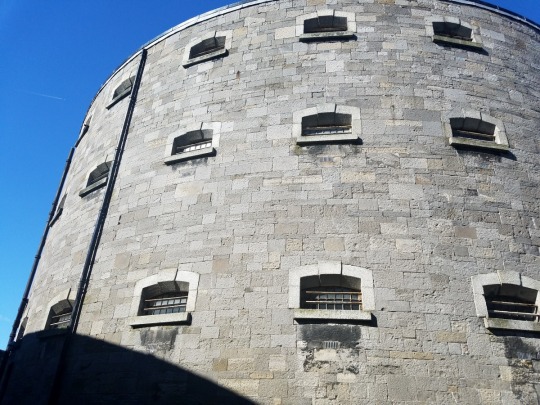
After decades of neglect and decay, the jail was eventually restored in the 1960s with the help of surviving former inmates. Today, it is a suitably bleak monument to the bravery and hardships of men and women who were willing to die so that their fellows could one day live in a better world.
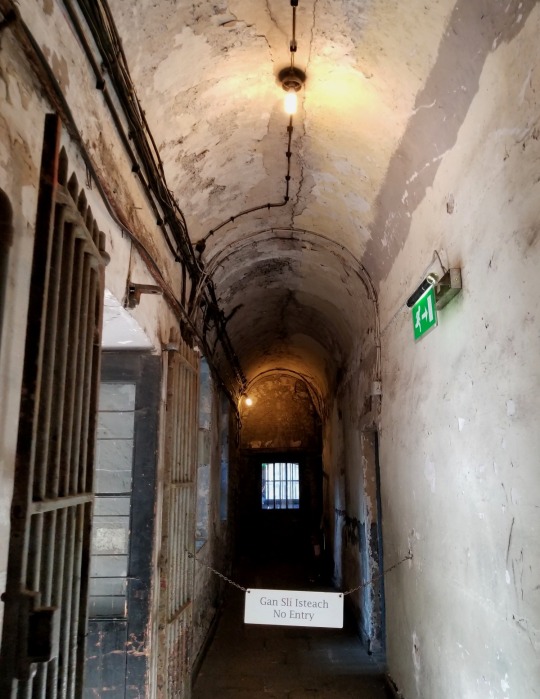

We learned that this prison was actually referred to as New Kilmainham. It was built to replace the old Kilmainham prison, where all prisoners were kept in one large chamber altogether. Men and women, children and adults, beggars and murderers. The new prison was meant to be (relatively) humane, with individual cells and stricter rules for how jailers could treat the prisoners. Still, it wasn’t great by modern standards.
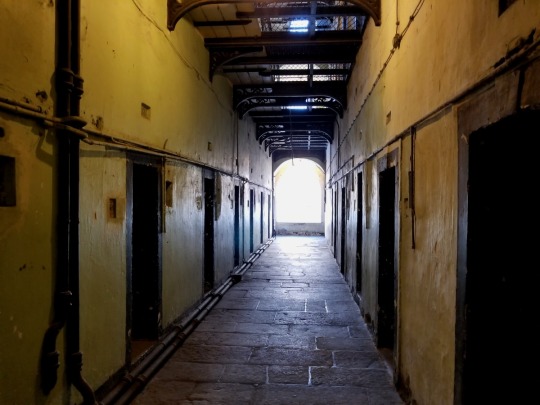

The prison is divided into two sections. The original Georgian wing, built in the 1790s, is a warren of dark stairways and cell-lined corridors. The later Victorian wing uses a “panopticon” design--a large, well-lit chamber with cells lining the walls, allowing jailers to see if anything was amiss in any of the cells with a simple 360-degree turn.


There are small plaques above some cells, marking where individual Irish political prisoners were held.
One of the condemned leaders of the Easter Rising was a woman named Constance "Countess" Markievicz. Constance was born into a wealthy Anglo-Irish landowning family and studied as an artist in Paris, where she met and married a Polish artist, the self-styled Count Casimir Markievicz. The couple returned to Ireland, where Constance became deeply involved with a variety of militant republican and socialist organizations. She designed the uniforms worn during the Easter Rising and is said to have advised Irish women to dress sensibly--with strong boots and a revolver.
Constance was a central member and active combatant during the Easter Rising but her execution was commuted to life imprisonment because she was a woman. When she was informed of this, she actually mocked her jailors for not having the decency to shoot her like the men. She was released by the British a year later and would remain an outspoken and controversial figure until her death in 1927.

Even after the inevitable War of Independence was over, the bloodshed was only hitting its peak. The Irish parliament narrowly voted to sign a treaty with Britain, which would give it limited independence similar to that of Canada and Australia at that time. The pro-treaty pragmatists saw it as a necessary stepping stone to end the fighting and work toward full independence in time. The anti-treaty idealists saw anything less than full separation and independence from Britain as a betrayal of Ireland and all the patriots who gave their lives for its freedom.
The treaty was signed, and the Irish Civil War began. Jessica and I had both always assumed that the Irish Civil War was between the North and the South--which was particularly American of us, now that I think about it. In any case, the Irish Civil War was strictly within the southern Republic of Ireland.
Kilmainham was again filled with political prisoners, but this time it was the pro-treaty Irish government imprisoning anti-treaty Irish dissenters. More people died in the one-year Civil War than in the three-year War of Independence, and more political prisoners were executed in Kilmainham by the Irish Provisional Government in that one year than by the British government during the previous hundred years.
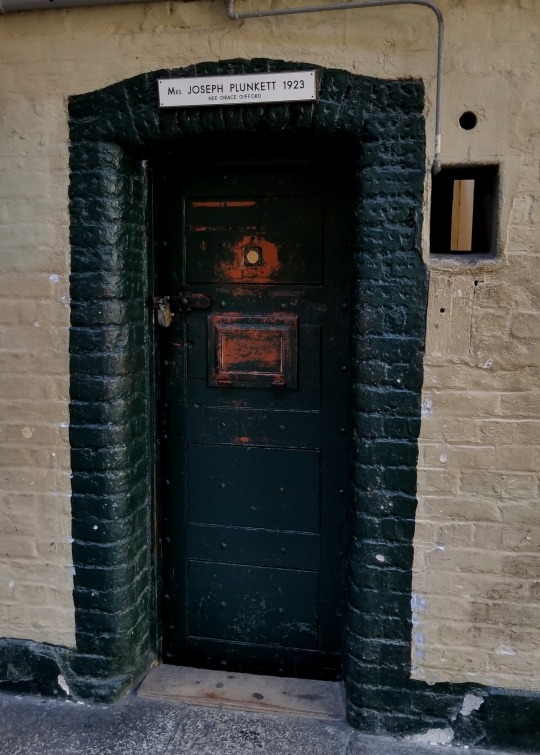
One of the anti-treaty prisoners held in Kilmainham during the Civil War was Grace Plunkett, widow of the Easter Rising leader Joseph Plunkett. The two were allowed to marry just a few hours before Joseph was executed--one of the sympathetic stories that sparked outrage against the British.

During her own stay in Kilmainham, Grace painted pictures on the wall of her cell, including one of the Madonna and Child that can still be seen through the cell door.

We saw an exercise yard where several anti-treaty prisoners were executed, as well as the rock-breaking yard where fourteen leaders of the Easter Rising were shot.

Thirteen were shot at one end of the yard, but the fourteenth--James Connolly--was already near death from wounds sustained during the fighting. Rather than let him die in a hospital, the British had Connolly brought to Kilmainham by ambulance, strapped him to a chair near the gate on the other end of the yard, and shot him.
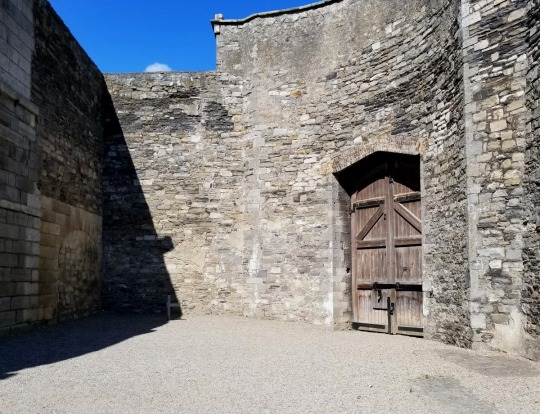
The executions took place slowly over ten days, with none of the condemned knowing until their last hours when it would be their day to. Once they were all dead, the British dumped their bodies in an unmarked mass grave without coffins. But rather than instilling fear as the British intended, the viciousness of these actions finally turned public sentiment against the British for good.
We learned from our guide that the Irish separatists were actually a minority up until that very point. World War I was in high gear in 1916, and most Irish people favored solidarity with Britain. Two years later, the Irish nationalist party Sinn Fein (pronounced "shin-fayn" and Gaelic for "we ourselves") won a landslide victory in Ireland's parliamentary election and renewed the Easter Proclamation of the free Republic of Ireland, kicking off the final War of Independence.
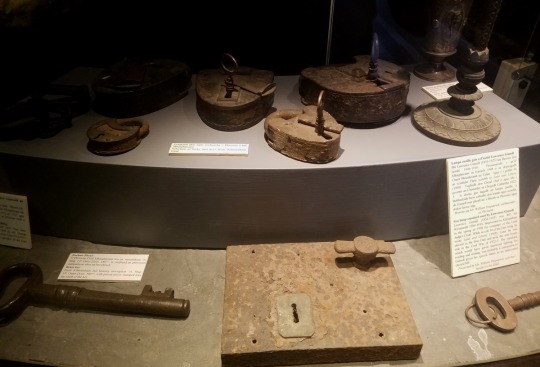
Even if we hadn’t gotten to tour the Gaol, the museum would have been worth the visit by itself. The first section includes artifacts from the Gaol’s history and talks about the hard lives of its prisoners. During the Great Famine, the Gaol was overwhelmed with people committing crimes just so that they could be sent to prison and get fed.
But so many people had the same idea that they ended up being still hungry and also in jail.



Another section covers the tumultuous years of the Easter Rising, War of Independence, and the Civil War. It includes a touching collection of the executed leaders’ last letters and personal belongings.

And another section covers the much longer history of Irish nationalism throughout the 18th and 19th centuries. It is a fascinating story with way too many details to go into here. (And given all the detail I’ve been willing to go into already, you know that’s saying something.) One of the more interesting stories involved a group of separatists called the Fenians recruiting a bunch of Irish-American veterans from the American Civil War to go over to Ireland and lead a short-lived revolution in 1867.
We had to pause halfway through our visit to the museum for some badly needed food and caffeine. Our time in jail had weighed heavily on us, and we were starting to bicker. It also didn’t help that we hadn’t eaten anything yet. But after a coffee and a bite to eat, we were back on track.

After Kilmainham, we took a bus over to St. Patrick’s Cathedral, which was built near the spring where St. Patrick is said to have performed his baptisms. It is a lovely cathedral, but in most ways very much like the other Anglican cathedrals we've seen already.


Actually, the fact that it is an Anglican church is one of the most interesting thing about St. Patrick's. Ireland is famously Catholic, and less than three percent of the Republic's population belongs to the Anglican Church of Ireland. Yet the country's most important church is Anglican. Of course, the answer to this riddle is as harsh and obvious as the stones of Kilmainham Gaol--the British.

We saw the regimental flags hanging in the north transept and finally learned about the fascinating tradition we'd been oblivious to in all the British cathedrals we'd visited in the last two months.

Whenever a British military regiment disbands or receives new colors, its old flag is retired or "laid up" in a cathedral or other important place. There, it is left in peace to slowly fade away--like the proverbial old soldier.

The cathedral is filled with beautiful stained glass windows, mostly dating from the late 1800s. That was when the Guinness family decided to spend some of their beer money to renovate the cathedral and beautify the surrounding working-class neighborhoods.
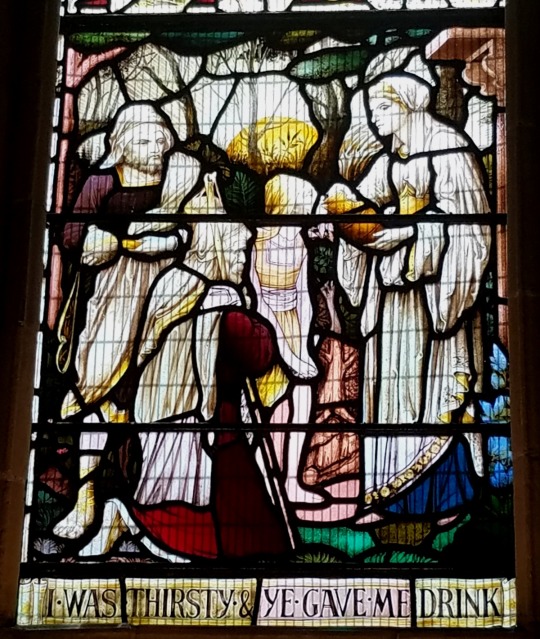
Fittingly, one of their windows bears the verse “I was thirsty and ye gave me drink.”
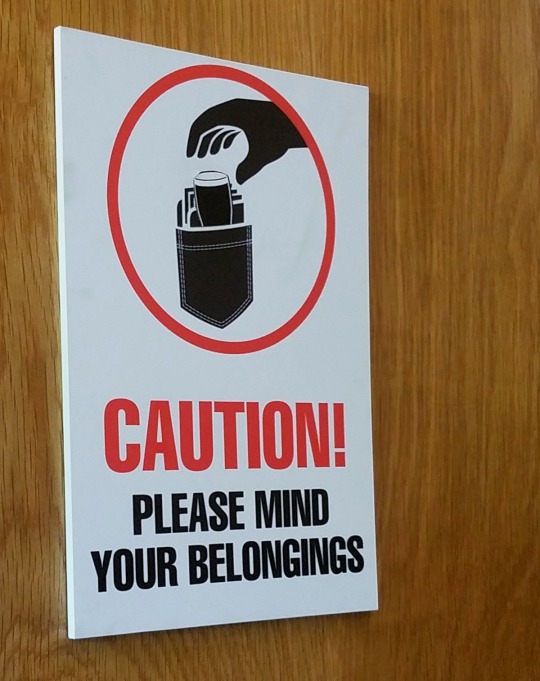
Speaking of Guinness, Jessica noticed a peculiar detail in one of the church’s warning signs about pickpockets.


For our last big stop of the day, we took a stroll through St. Stephen’s Green to the National Museum of Archaeology, which is right across the street from Bram Stoker’s old house. (Disappointingly, the museum didn’t address vampires at all.)

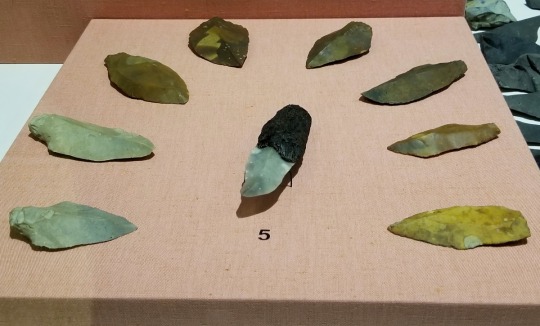
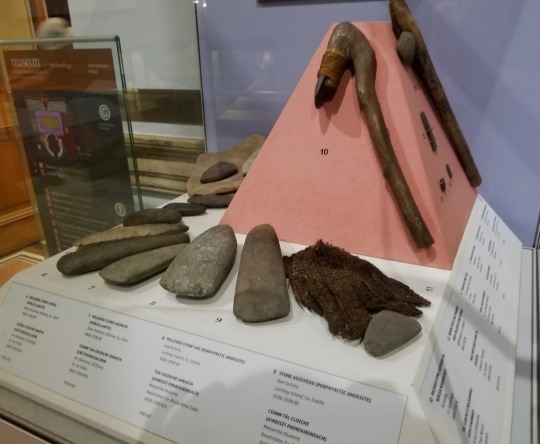
The museum is compact but amazingly rich with fascinating and well-presented artifacts. Starting at the entrance, a clockwise walk around the main room takes you from the prehistoric stone age up into the early iron age.

One entire side of the room is occupied by an extraordinary 4000-year-old canoe. Carved from a single giant log, it measures over 45 feet long.


Even within the bronze-age artifacts that make up the bulk of the collection, we could see how the tools and weapons grew more refined over time.
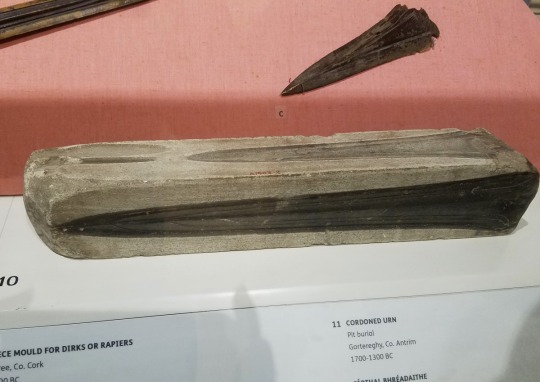
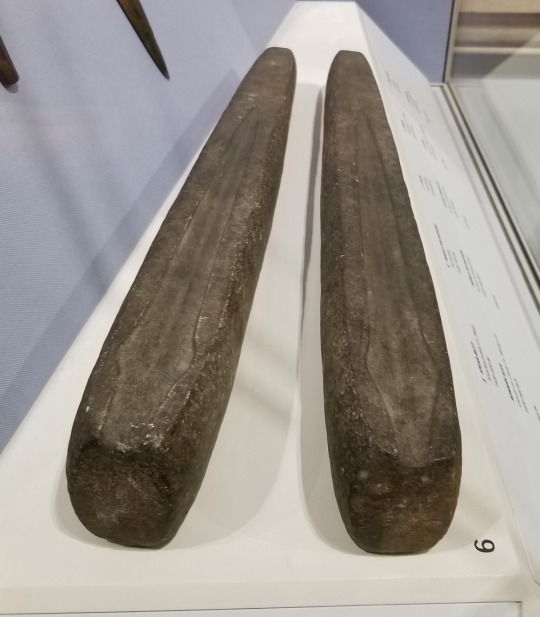
For me, one of the most interesting artifacts was a set of molds that the ancient Irish used to cast bronze blades. It never occurred to me that bronze-age weapons were cast, not forged. I don’t even know if you can forge bronze, come to think of it. (Actually, I looked it up. You technically can, but only with certain alloys of bronze. I don’t think that the ancient Irish had that level of metallurgical sophistication. If they did, they would have just made steel.)
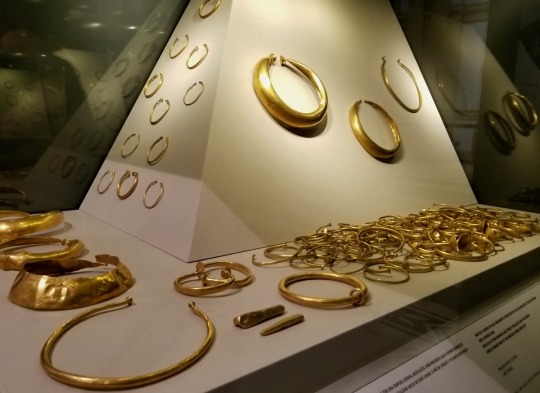

In the center of the room is a vast display of ancient gold jewelry.
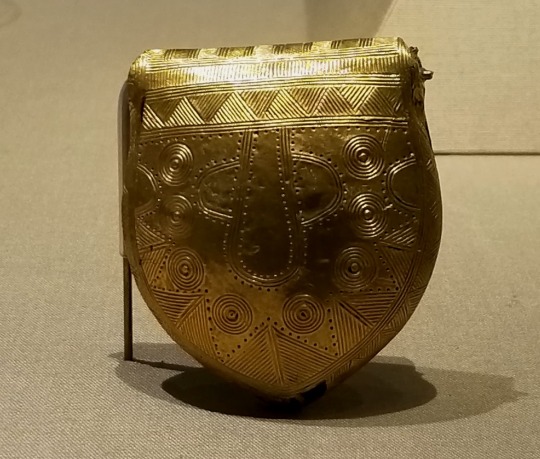
Even here, you can see the intricacy of design that foreshadows the amazing Celtic knotwork designs that would flourish in the Middle Ages.
Before we went to see those medieval artifacts in the room known as the Treasury, we visited another display on mummies. Not Egyptian mummies--Irish bog mummies.
(No, I won’t post any pictures.)
Despite being very wet, the peat bogs that make up much of Ireland are almost completely starved of oxygen when you get down deep in them. That’s why the island is such a rich source of amazingly preserved artifacts. And some of those artifacts are people.
In the more rural areas of Ireland, people still cut peat to fuel their furnaces in the winter. They say that the peat grows about a meter every thousand years, so you don’t need to dig very deep to find things that are very old. Every so often, one of these people will dig up a bead or bracelet with their peat. And once in a while, someone will dig up a body.
The museum had three preserved bodies on display, tucked away in respectfully shielded rooms so that you didn’t have to see them unless you really wanted to. Jessica didn’t, but I did.
They were fascinating and unsettling at the same time. Imagine walking into a room with what looks like a wrinkled old leather jacket on a table. But instead of cuffs, the arms end in perfectly preserved brown leather hands--nails, palm lines, and even fingerprints--fingers curled in an uncannily human gesture.
Anyway, on to the treasury.

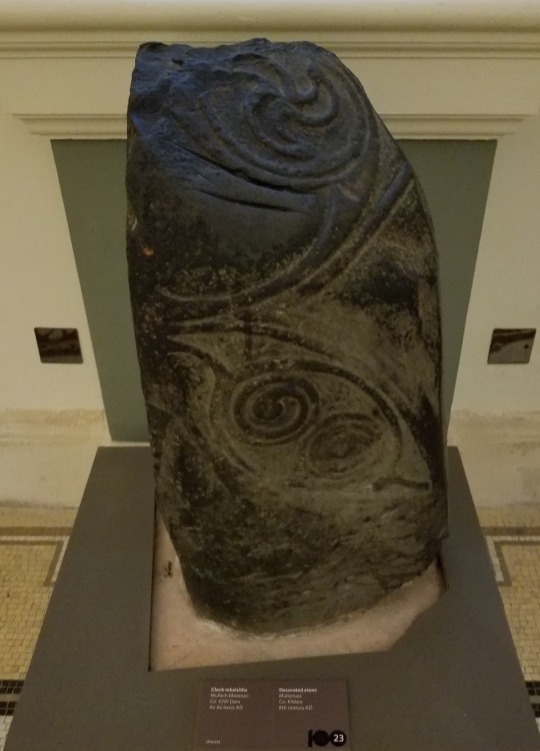

The treasury includes some of the most impressive ornamental metalwork I’ve ever seen anywhere. The Vikings may have been a scourge to Ireland, but the metalworking skills they brought with them allowed the Celts to transform their traditional knotwork patterns into truly remarkable masterpieces.


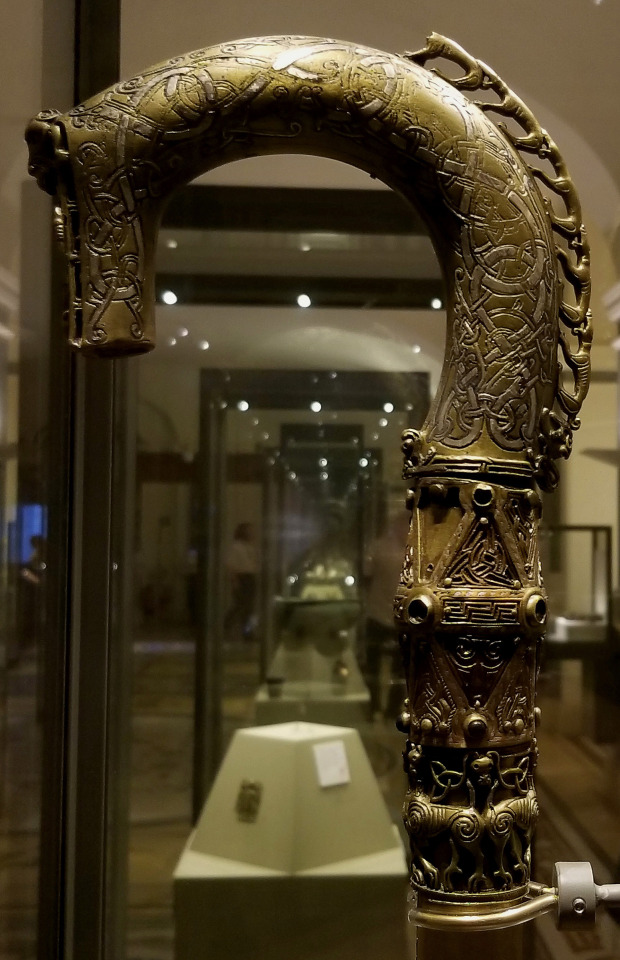

The most famous piece, and probably the most impressive, is the Tara Brooch.
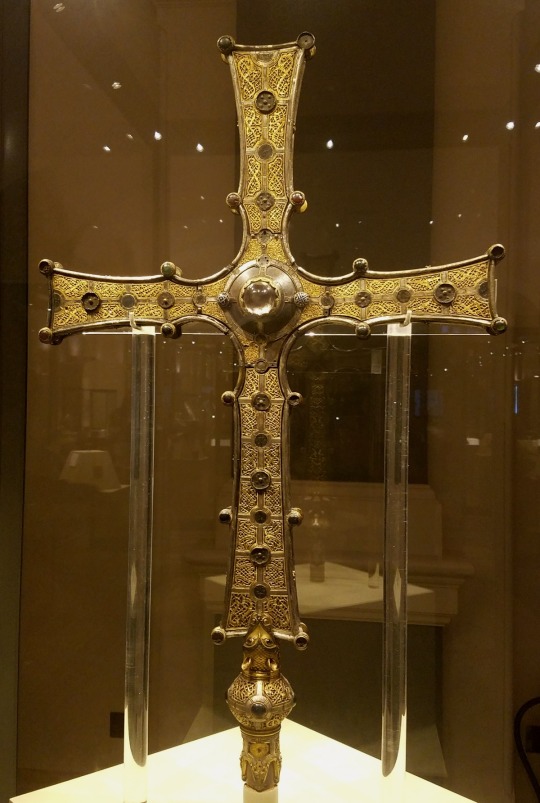

Another is the Cross of Cong. It was originally made to fit on top of a priest’s staff and is said to contain a fragment of the True Cross. For centuries after Henry VIII broke away from the Catholic Church, devout priests of Cong kept the cross secret and safe until the 1800s, when it was rediscovered by the outside world and eventually moved to the museum.
As it happened, we would be visiting Cong the very next day.
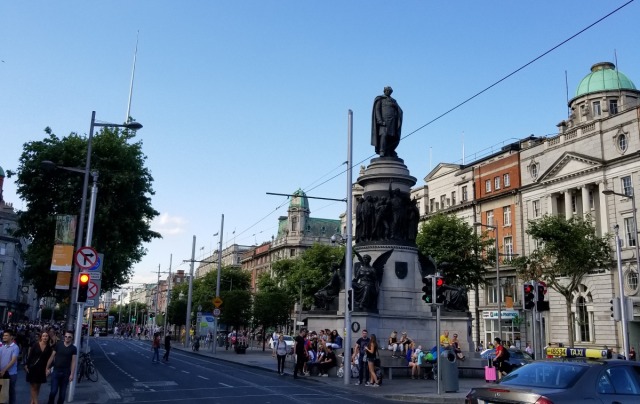
Before heading home from the museum, we went for a bit of shoe shopping. Jessica’s shoes had gotten a little run down--the recent mudding incident in Wales hadn’t helped the matter--and she wanted to replace one of her two pairs with something Irish.
My own shoes were getting a little thin in the heel, too, but in the end I decided to keep them for a while longer. We’d be doing a Scottish bog walk in less than two weeks, and I didn’t want to replace my one pair of shoes with a new one just to muck them up right off the bat.
Back home, we cheered as Croatia beat out Russia in penalty shots to move on to the World Cup semifinals. The other semifinalists were England, France, and Belgium. I was rooting for either England or Croatia, which meant that in Ireland I was rooting for Croatia.
Next Post: The Hills of Connemara
Last Post: Story and Song–the Book of Kells and a Musical Irish Pub Crawl
0 notes